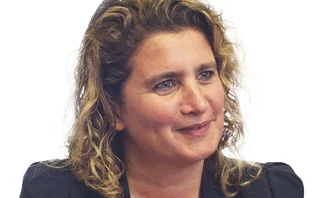
CRO of the year: Robert Rupp, The Hartford
Insurance Risk Awards 2015: The Hartford emerged from the financial crisis heavily wounded but has been steadily working its way back to better health. CRO Robert Rupp has been a major contributor to the recovery

When Robert Rupp became The Hartford’s chief risk officer in 2011, the insurer was reeling after it suffered a loss of $2.7 billion in 2008. The company survived after taking a $3.4 billion bailout from the Troubled Asset Relief Program following the financial crisis, but its issues weren’t over.
“The guts of the crisis had passed, but the impact on companies and their responses to the crisis were continuing and so for me, it wasn’t as though the event was over. We were still managing our portfolio relative to what the crisis had caused,” Rupp says.
Four years later, The Hartford’s recovery is well under way, but it might not have fared as well if Rupp and chief executive officer Liam McGee, who passed away in February, hadn’t developed such a close friendship. Rupp says there’s “absolutely no question” the relationship contributed to The Hartford’s success over the past four years.
“Liam McGee was a great leader and a great friend. Liam and I met and we instantly liked each other. I’ve seen instances where there’s an adversarial relationship between businesses and risk management; it never works well,” Rupp says.
When Rupp was hired, he brought with him ideas about best practices and, along with his colleagues, took a hard look at The Hartford’s balance sheet. But he is at pains to emphasise that The Hartford’s recovery over the past four years wasn’t just his doing.
The guts of the crisis had passed, but the impact on companies was continuing
“This is a collective effort for a whole lot of people at this company… I’m really proud to be getting the award, but it’s way more than just me,” Rupp says. The Hartford was also the recipient of the best governance, risk, and compliance program at a large-cap company award from the New York Stock Exchange in June.
The company’s recovery began for Rupp when he joined Hartford in November 2011. Coming from the financial services sector at BNY Mellon and JP Morgan, he says he had a good grasp of best practices in the financial world and he and other executives worked on incorporating those into the company. This meant drawing from US bank stress tests, standards on risk management from the Office of the Comptroller of the Currency and the Federal Reserve, and insights into stress testing from the European Insurance and Occupational Pensions Authority.
Rupp says it was important for the executives and board to rethink the company’s risk appetite. “We’re in the risk-taking business, so you ask yourself really basic questions: how much risk do you want to take and what kind of risk do you want to take?” he says. Failing to pay enough attention to these fundamental questions is what got people in trouble during the crisis, he believes.
Taking a look at the balance sheet was imperative, Rupp says, as the insurer looked to eliminate unnecessary risks. In 2012, The Hartford announced a corporate strategy to focus on its P&C, group benefits and mutual funds businesses. Following the announcement, the company sold its US individual life and retirement plans businesses and put its annuities business, which contributed to stock price volatility, into run-off.
Executives also took the decision to sell the UK and Japan annuity businesses, which eliminated the most volatile portion of the annuity book. To assist in these sales, the company first had to comprehensively overhaul its variable annuities hedging strategy, which it did alongside developing a ‘model portfolio’ approach to make sure risk and return are balanced in its investment portfolio going forward.
Rupp says these choices were successful and well received by the market, which is borne out by the company’s stock price, which has risen from around $16 a share in early 2012 to more than $40 in June this year.
Another question the executives had to answer was whether risk management was simply a defensive exercise, says Rupp. “And my answer to that is categorically no. It is both defence and offence. Also, embedded in that, is that it’s not simply math. What we do is part science and part art,” he says.
The economic capital framework now in place at The Hartford includes monitoring daily mark-to-market and daily value-at-risk metrics for the whole company, and the insurer runs 25 standard stress tests every quarter alongside tailored stress tests to target idiosyncratic risks.
Beyond his responsibilities as CRO, Rupp also heads a group to help members of the military and veterans, not just within the company but in the wider community as well.
Susan Johnson, head of diversity and inclusion at The Hartford says: “He talks a lot about how he sees value in everybody’s life experiences. He truly appreciates what people bring to the table, regardless of any difference. He really does see the value in talent and he leverages that wherever he sees it.”
Only users who have a paid subscription or are part of a corporate subscription are able to print or copy content.
To access these options, along with all other subscription benefits, please contact info@risk.net or view our subscription options here: http://subscriptions.risk.net/subscribe
You are currently unable to print this content. Please contact info@risk.net to find out more.
You are currently unable to copy this content. Please contact info@risk.net to find out more.
Copyright Infopro Digital Limited. All rights reserved.
As outlined in our terms and conditions, https://www.infopro-digital.com/terms-and-conditions/subscriptions/ (point 2.4), printing is limited to a single copy.
If you would like to purchase additional rights please email info@risk.net
Copyright Infopro Digital Limited. All rights reserved.
You may share this content using our article tools. As outlined in our terms and conditions, https://www.infopro-digital.com/terms-and-conditions/subscriptions/ (clause 2.4), an Authorised User may only make one copy of the materials for their own personal use. You must also comply with the restrictions in clause 2.5.
If you would like to purchase additional rights please email info@risk.net
More on Insurance
The future of life insurance
As the world constantly evolves and changes, so too does the life insurance industry, which is preparing for a multitude of challenges, particularly in three areas: interest rates, regulatory mandates and technology (software, underwriting tools and…
40% of insurers fail to specify climate as a key risk – LCP
Despite regulators’ urging, many UK and Irish insurers omit climate from risk statements, says report
Libor leaders: Prudential takes SOFR for a test drive
Test trades have allowed US insurer to start getting used to a life without Libor
Fed to push ahead with capital regime for single US insurer
Prudential faces risk capital add-ons unless it sheds “systemically important” label
Brexit dims hopes for Solvency II change in UK
Lawyers say political tensions may have killed off chance of reform, following PRA U-turn
BoE creates volatility adjustment ‘stepping stone’ for insurers
Dynamic VA may be used for assets that fail to qualify for matching adjustment, say experts
No plans to scrap systemic insurer rules, says IAIS chair
A US regulator claims Europeans asked IAIS to chart own course after FSB moved to ditch G-Sii list








